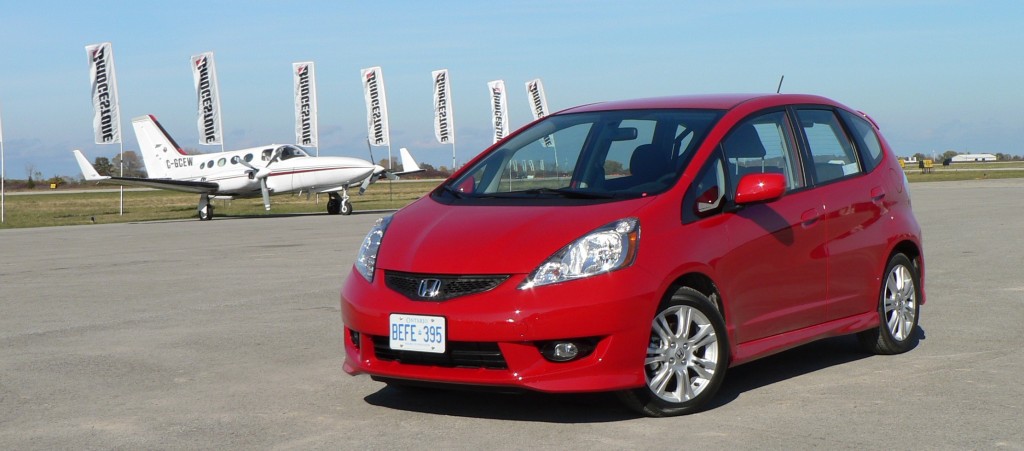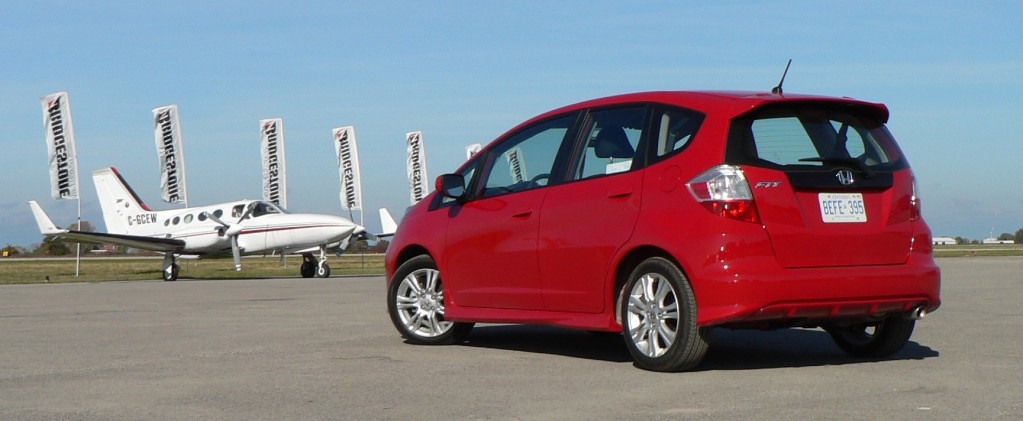Road Test: 2009 Honda Fit
[svgallery name=”09_Honda_Fit”]
Story and photos by John LeBlanc
When the first oil crisis hit with its associated jump in fuel prices and shortages way back in 1973, smaller, more fuel efficient family transportation alternatives to the traditionally larger Detroit land yachts were few and far between. Even the small cars that could be had, like the Ford Pinto, Chevrolet Vega and Chevette, AMC Gremlin, or funny sounding little foreign cars like Firenza, Colt, Corolla or B210s, were cramped, poorly made, and not really all that more fuel efficient. As not very compelling options, mid-1970 small cars were more like penalty boxes to own and drive than real solutions to a growing problem.
Flash forward three decades. Families are still faced with crisis. Today, it’s not only the high cost of gas, but also a severe global economic meltdown. Like déjà vu all over again, belt tightening and frugality are back in fashion.
Thankfully, 36 years after that first oil crisis, small cars have grown up and matured way beyond anyone who drove the first Honda Civic could ever have imagined. And, frankly, that means most families have few reasons to not own a small car. And one of those small vehicles with the least number of excuses is Honda’s revamped-for-2009 five-passenger Fit.
Honda makes its subcompact even fitter
Already on sale in Japan for five years, the first five-door, front-drive Fit in Canada arrived in 2006. Today, in one of the most competitive auto markets ever, Honda has sagely decided not to wait for its subcompact to get too stale, blessing it with a substantial redo for 2009.
Overall, the 2009 Fit’s looks remain familiar. The 2009 iteration has less of the old model’s “egg-on-wheels” proportions. But it’s still a relatively tall, monobox shape, with the archetypical folded-paper school of Japanese car design.
A new, more powerful four-cylinder engine, improved suspension, steering and body rigidity enhancements, a bit more interior room and a higher level of standard safety equipment are the highlights on the Fit’s “what’s new” list this year.
Premium pricing—premium kit
What isn’t all that new is the Fit’s relatively premium pricing. Where the MSRP on a Chevrolet Aveo5 can be as low as $13,770, Honda’s subcompact continues to be priced at the upper reaches of the bottom feeder class with a 2009 Fit DX starting at $14,980. Good thing, then, the updated 2009 Fit continues its tradition as a well-equipped “you get what you pay for” value proposition. Even base models brings a wealth of safety kit for modern families that you’ll pay more for—or simply—can’t get—on rivals. Four-wheel anti-lock brakes with electronic brake distribution, active front seat head restraints, front side airbags with passenger-side occupant position and side curtain airbags are standard on any Fit.
Three rungs up from the DX on the Fit ladder—at the top—is my tester: a $19,280 Sport with a five-speed manual transmission. The Sport badge adds alloy wheels, an underbody aero kit, rear roof spoiler, fog lights, security system with keyless remote entry, cruise control and an audio system with six speakers and USB connectivity.
Class-leading interior continues
One reason to justify the subcompact Fit’s compact car price, is its upscale and roomy-for-its-class interior. The 2009 version only improves on the last model’s already well-thought-out ergonomics, excellent build quality and flexible and roomy rear seating and cargo areas.
Inside, the little Honda really acts and feels like a much larger car. Already roomy for its class, the 2009 Fit now has a 50 mm longer wheelbase, a 30 mm wider cabin and 10 mm taller cabin. As in that last Fit, placing the car’s fuel tank in the middle of the chassis allows the floor in the rear to be relatively low. As such, occupants enjoy more legroom, headroom and hiproom than last year’s model.
No other subcompact has the Fit’s 60/40 split rear seats that can fold down or have its seat bottoms flip up to provide a tall space for garden gnomes or sliding in a mountain bike sideways. Even with all five Fit seats in position, it can handle the jetsam and flotsam of most families— there’s 585 litres of cargo capacity behind the second row, almost three times that of the Aveo5.
Practicality and performance in one small package
Volumetrically, the tiny Fit thinks it’s a minivan. Yet underneath, it has the heart of a hot hatch. For all its modern family functionality, the 2009 is actually a lot of fun when you want to drive it like the kid-next-door’s slammed ’93 Civic Si.
As we all know, unfortunately, with maturity comes more weight. So for 2009, the Fit has put on 27 kg in curb weight, now 1,147 kg. Only the Nissan Versa is heavier in this class. While much if that extra avoirdupois—62.3 per cent, actually—ended up at the front of the car. Normally, this is a recipe for unrelenting understeer. But not in the Fit.
It still has struts up front and a twist-beam axle out back, but despite the added girth and weight, it’s still offers balanced handling with a flat cornering attitude normally associated with more expensive sport compacts. The Honda’s electric steering is quick and accurate, with a lot of feel. And the one-inch larger wheels and tires this year—185/55 R16 on the Fit Sport—add even more to its cornering abilities. Just don’t expect a limousine ride. The Fit’s short wheelbase/taut suspension combo means its ride can be choppy on the highway.
Being a Honda, it’s no surprise the Fit’s new 1.5-litre four is sewing machine smooth. With 117 hp (up 8 hp) and 106 lb-ft of torque (up an inconsequential 1 lb-ft) it’s 0-100 km/h run is a class-competitive 10.5 seconds.
The sweet revving motor also delivers the raisin d’etre for many who are deciding on the Fit in the first place: excellent fuel consumption ratings. How does of 7.2 L/100km city and 5.7 L/100km highway sound? You can do better—Honda’s new Insight gas-electric hybrid scores 4.8L/4.5L—but then it costs over 50 per cent more than a base model Fit.
The shift quality of the Fit’s five-speed is crisp, if a bit notchy on the one-to-two shift. A $1,200 five-speed autobox with steering wheel mounted paddle shifters is available, but it saps the life out of the Fit’s performance.
So, how much car does your family really need?
In the end, if you think of the Fit as a fun-driving micro-minivan, you’ve neatly summarized its versatile nature. And unlike small cars in the mid-1970s, the excuse-free Honda Fit is a real alternative to larger, more traditional family transportation. More efficient, roomier, safer, than its predecessor, the 2009 Honda Fit is a case study in just how far the small cars have improved in the past four decades.
2009 Honda Fit Sport 5M
Base price: $19,280
Type of vehicle: FWD subcompact five-door hatchback
Engine: 1.5L, 16-valve DOHC I4
Power/torque: 117 hp/106 lb.-ft.
Transmission: Five-speed manual (opt. Five-speed automatic)
0-100 km/h: 10.5 seconds
Fuel consumption (city/hwy., est.): 7.2/5.7 L/100 km
Competition: Chevrolet Aveo5/Pontiac Wave, Kia Rio5, Nissan Versa, Toyota Yaris, Volkswagen City Golf
ROAD TEST SUMMARY
PROS
Generous and flexible seating and cargo options
Most fun-to-drive subcompact this side of a Mini Cooper
Refined interior
CONS
Jiggly highway ride
Notchy manual transmission
Relatively premium pricing







![[del.icio.us]](https://www.straight-six.com/wp-content/plugins/bookmarkify/delicious.png)
![[Digg]](https://www.straight-six.com/wp-content/plugins/bookmarkify/digg.png)
![[Facebook]](https://www.straight-six.com/wp-content/plugins/bookmarkify/facebook.png)
![[Google]](https://www.straight-six.com/wp-content/plugins/bookmarkify/google.png)
![[Reddit]](https://www.straight-six.com/wp-content/plugins/bookmarkify/reddit.png)
![[StumbleUpon]](https://www.straight-six.com/wp-content/plugins/bookmarkify/stumbleupon.png)
![[Twitter]](https://www.straight-six.com/wp-content/plugins/bookmarkify/twitter.png)
![[Email]](https://www.straight-six.com/wp-content/plugins/bookmarkify/email.png)